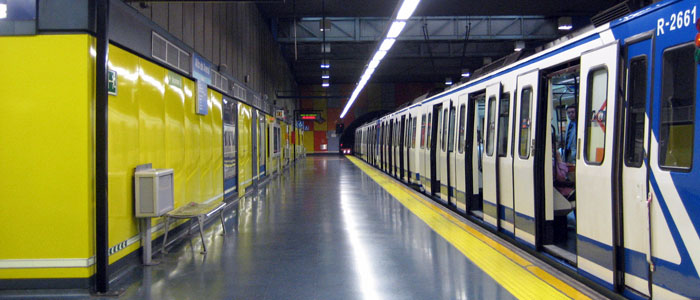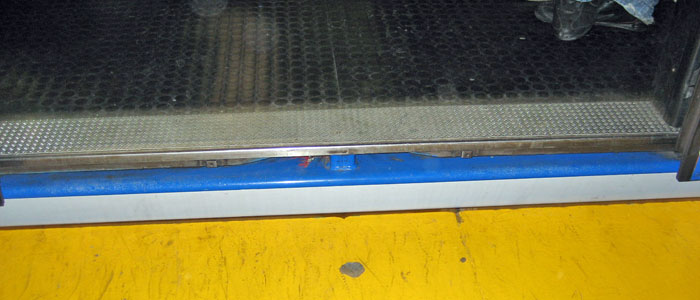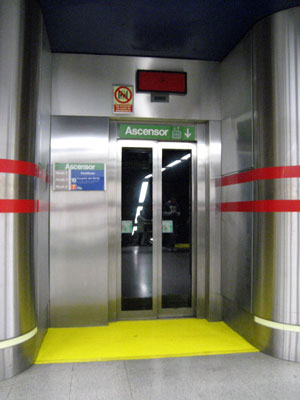Madrid, Spain Travel Guide
About Getting Around Attractions Hotels Eats & Nightlife Essentials & Practicals
Wheelchair Accessible Metro Lines

Madrid metro stop
Overview: Metro “line” are wheelchair accessible: it’s the metro “stops” that may not be, though many are. In the stations on the platforms, there are handicap signs at the ends of the platforms where the front or cab of the metro trains stop. The first two metro train cabins have designated handicap spots with rails. There are no seats in these designated spots. Most of the time, there are people standing there. there is about a 2 to 4 inch gap (varies) from the platform to the actual door of the metro. There is about a 2 to 4 inch climb up as well, again, varies. Unless you have front casters that are one to two inches and can not do a wheelie, boarding on the Madrid metro is fairly easy. Of course at peak times in the morning and evening, the metro can be crowded. But, people make room. The metro maps in the platform areas list the current stops with lifts so be sure to read the metro map carefully.

The gap between platform and metro in Madrid
Lifts, Elevators: Lifts are called “Ascensors” are located at one end of the stop. As mentioned previously, many of the stops on the metro maps indicate accessibility by the handicap sign.
The elevator buttons read anywhere from “0” to “-3.” The number 0 represents the street, if you want to exit on the street. The negative signs next to numbers represent how far down a metro line is. A -3 is of course, three levels underground.

Ascensor or lift in Madrid metro station
WHEELCHAIR ACCESSIBLE METRO STOPS
Line 1 (Atocha, Chamartin) – Light blue. From south to north. Valdecarros, Las Suertas, La Gavia, Congosto, Villa de Vallecas, Sierra de Guadalupe, Miguel Hernandez, Alto del Arenal, Atocha Renfe, Sol (track), Iglesia, Cuatros Caminos, Chamartin, Bambu, Pinar de Chamartin
Line 2 – Red. From east to southwest to north. La Elipa, Goya, Sol, Canal, Cuatro Caminos
Line 3 – Yellow. From south to northwest. Villverde Alto, San Cristobal, Villaverde Bajo-Cruce, Ciudad de los Angeles, San Fermin-Orcasur, Hospital 12 de Octubre, Almendrales, Legazpi, Delicias, Palos de la Frontera, Embajadores, Lavapies, Sol, Callao, Plaza de Espana, Ventura Rodriguez, Moncloa
Line 4 – Rust/brown. From west to east to north. Arguelles, Goya, Canillas, Mar de Cristal, San Lorenzo, Parque de Santa Maria, Hortaleza, Manoteras
Line 5 – Light green. From west to south to northeast. Casa de Campo, Empalme, Aluche, Eugenia de Montijo, Piramides, Acacias (?), Callao, El Capricho, Alameda de Osuna
Line 6 – Grey circular. Plaza Eliptica, Lucero, Principe Pio, Arguelles, Moncloa, Ciudad Universitaria, Guzman el Bueno, Cuatro Caminos, Nuevos Ministerios, Conde de Casal, Arganzuela-Planetario, Legazpi
Line 7 – Orange. From northwest to south to east. Pitis, Lacoma, Avenida, Ilustracion, Penagrande, Antonio Machado, Valdezarza, Francos Rodriguez, Guzman el Bueno, Islas Filipinas, Canal, Alonso Cano, Gregoiro Maranon, Estadio Olimpico, Barrio del Puerto, Costada Central, La Rambla, San Fernando, Jarama, Henares
Line 8 – Pink. From west to northeast. Airport line. Nuevos Ministerios, Colombia, Pinar del Rey, Mar de Cristal, Campo de las Naciones, Aeropuerto T1-T2-T3, Barajas, Aeropuerto T4.
Line 9 – Purple. From south to north. Arganda del Rey, La Poveda, Rivas Vaciamadrid, Riva Urbanizaciones, Puerta de Arganda, San Cipriano, Vicalvaro, Valdebernardo, Colombia
Line 10 (Principe Pio, Chamartin) – Dark blue. From south to north. Puerto del Sur, Joaquin Vilumbrales, Cuatro Vientos, Aviacion Espanola, Colonia Jardin, Casa de Campo, Batan, Lago, Principe Pio, Plaza de Espana, Gregorio Maranon, Nuevos Ministerios, Chamartin, Tres Olivos, Mortecarmelo, Las Tablas, Ronda de la Comunicacion, La Granja, La Moraleja, Marues de la Valdavia, Manuel de Falla, Baunatal, Reyes Catolicos, Hospital de Norte
Line 11 – Dark green. From south to north. Short stop with handicap accessible stops on every stop from La Peseta to Plaza Eliptica
Line 12 – Green/Yellow. Metrosur line. This line is a circular running southwest of Madrid’s center. Virtually every stop is handicap accessible.